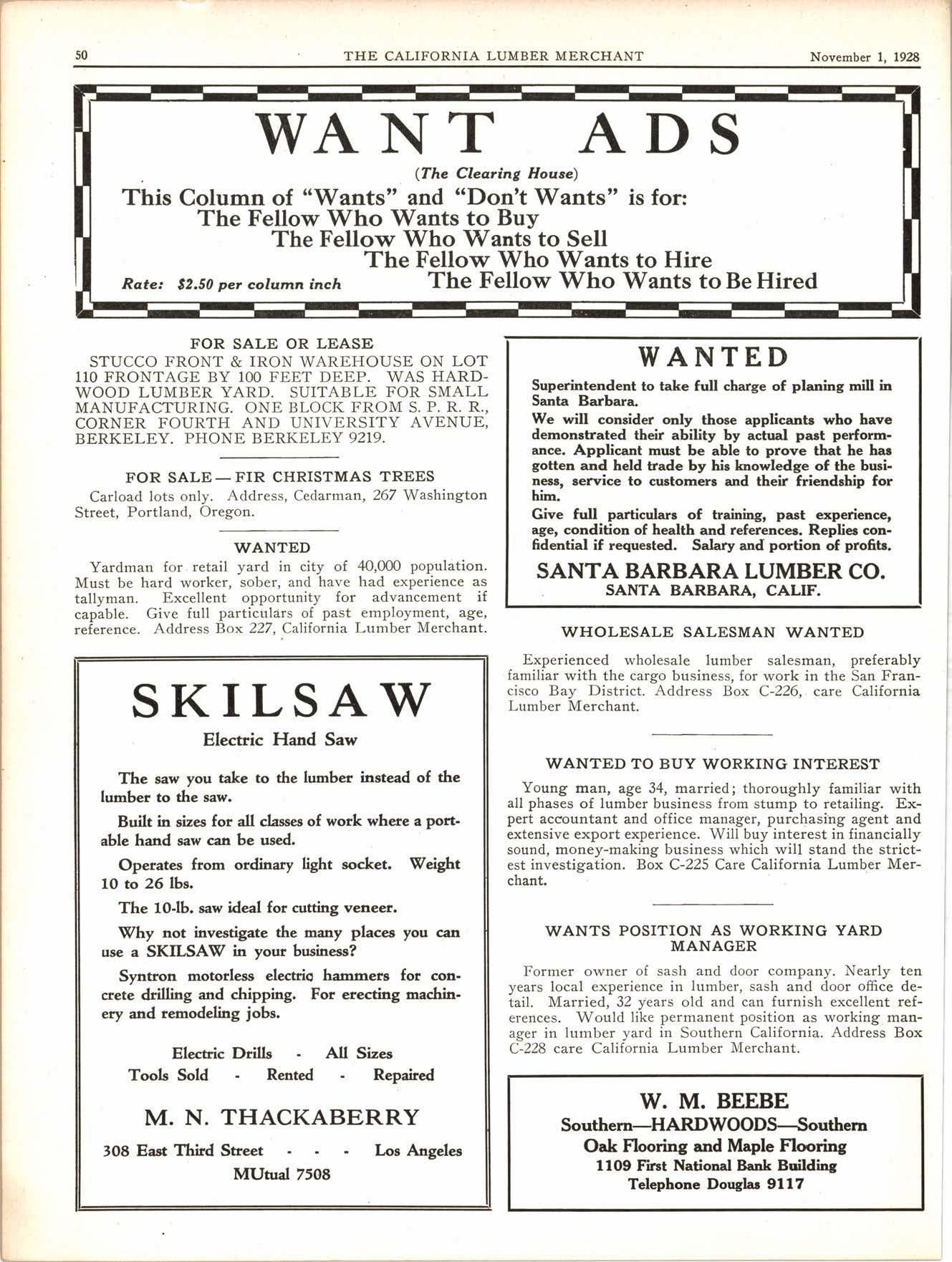
3 minute read
Random Editorial Ramblings
By Jack Dionne
You men of the lumber making world who own timber and mills and make lumber at a comparatively known and fixed cost and condition, pity the mill man of the Northwest who buys his logs in the open market-as a very great number do. His raw material is logs. He buys them in rafts. The professional logger owns the timber. This logging person keeps in close touch with the market. Frequently he is a manufacturer also. Every time the lumber market goes up, the log market follows. It's a bitter pill, but the doctor says {'Take it." I{e squirms and kicks like the kid facing the castor oil spoon-but he gets it. It's a tough break for the mill man. The logger has no higher costs today than he had last spring. But logs have gone up a whole lot. This logger is the guy who keeps the logger-depending mill man from worrying about his income tax. There is probably sornething to be said on the logger's sid+but it's tough on the manufacturer just the same.
l*ttl
Every catastrophe brings its lessons. Whether we shall profit by them or not, is always, doubtleSs, an operr question. Every time some disaster of storm or quake occurs' much is said and written anent the "lessons" in building taught by the trouble. This was especially true concerning the recent great huricane that devastated Florida. Nothing new was taught by the Florida experience. Shoddy construction met quick disaster. Stout and intelligent construction fought the storm-and won. Good wood construction stood off fhs 5fq1rn-as it always does. Poor wood construction was demolished. Broadcasting pictures of wood that stood, and of other materials that did not, is unintelligent. It's a game that is far from one sided. Good brick and concrete structures gave good account of themselves. Poor ones caved in. Boost wood. When well constructed it is wonderful protection against storm or quake. But let the other fellow alone. The only wood opetrator who has any sense in his knocking is the woodpecker. ****
Roger Babson, writing in Collier's on great business successes, tells of various great organizations "which have advanced from humble beginnings to their present position of power and profit by the force of tireless publicity." Doubtless ! The examples all about us are too numerous to admit of argument. And don't forget ! The accent is on the "tireless" rather than on t'publicity". No one ever built a business, or sustained one, by sporadic or faint hearted advertising. Never ! To have something interesting to tell about you,business, and then to have the courage and the vision to dig into the bank roll and keep on footing the bills until the business created begins rolling it backTHAT is the test. To quit pulling in the middle of the -hill means the loss of the investment to date.
Not so many years ago two old school gentlemen of the South, gathered their small means together and started selling a blend of coffee they concocted; one that tickled their own palates so they thought others might like it. One of them sold his small inheritance-a Kentucky farm -to pay for his share in the business. Both of them be lieved in advertising. And they advertised as no coffee was advertised before. Other coffee people thought they were wasting their money. They sold out the other day for forty-five million dollars. About ten million dollalr represented their physical equipment. The other thitryfive went to pay for that advertised name-Maxwell House. Ask J. W. Neal, of Houston, Texas, one of t*re world's kindliest and wisest men, if publicity pays.
Some of theie days we are going to be able to recite numerous examples of lumber advertising that paid. It won't be long. For now, for the very first time in lumber history, the industry is finally deciding that lumber pub,licity is something better and wiser than the vain aim of seeing your name in print. When the history of lumber is written, it will be said-"the year 1928 marked the dawn of intelligent publicity." Ftom now on there will be plenty of examples to point to, of organizations, and associations, and corporations that will understand that the same potent force that has maile other commodities hugc successes, applies to lulrber* likern'ise. \f,/atch 'ern !
Watch that marvelous campaign that Weyerhaeuser is putting on. Attractive, punchful, creative advertising; no doubt. But it isn't the ads that makes this campaign notable. It's the THING they are advertising. "flow can lumber advertising be made attractive?" is a question often asked. Weyerhaeuser has answered that question by following the lead of the merchants in other lines. Just as the housewife today wants her groceries and supplies de livdred in packages, or containers, rather than in the bulk fashion of other days-protected, labeled plainly and attractively marked as to conte{rts-so is Weyerhaeuser packaging and protecting and labeling their lumber. And before they could so treat it they naturally improved its appearance. And so we see them advertising "wasteless lumber", "trimmed square at both ends", "ready to use", j'cut to exact lengths", "thoroughly seasoned", t'packaged", "labeled for identification", "grade stamped on label", "prevents mistakes", t'establishes confidence", and get thisr"Weyerhaeuser stands squarely behind every package." "Packaged and guaranteed", they say, "4-squar'e lumber", sold to "4-square dealers", with attractive signs fof t.he dealer's door, so the public will know that there they may get this advertised and protected and guaranteed stock Will it PAY? Just as certain as it paid Wrigley-or Maxwell House.
(Continued on Page 8.)










